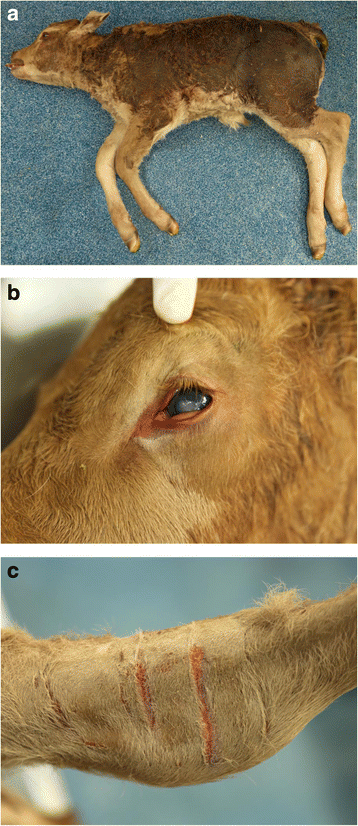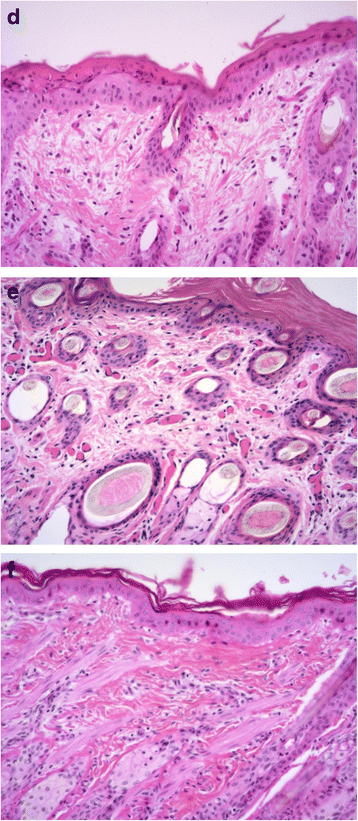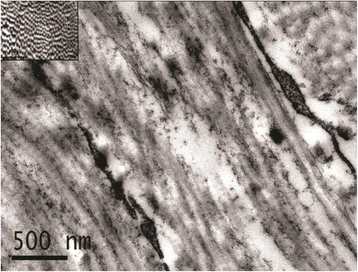Dermatosparaxis in two Limousin calves
- PMID: 27777746
- PMCID: PMC5070005
- DOI: 10.1186/s13620-016-0074-5
Dermatosparaxis in two Limousin calves
Abstract
Background: An unusual presentation of skin disease was identified in two related neonatal Pedigree Limousin calves presented to University Veterinary Hospital, University College Dublin, following detailed post mortem examination a diagnosis of dermatosparaxis was made. Dermatosparaxis in animals or Ehlers Danlos Syndrome, which is the analogous condition seen in humans, is a connective tissue disorder characterised by extreme skin fragility. To the authors' knowledge this is the first report of such a diagnosis in the Limousin breed and the features of this lethal phenotype were severe in comparison to previous reports of the condition.
Case presentation: Two calves, which were full siblings, a pedigree Limousin bull (Calf A) and pedigree Limousin heifer (Calf B) were examined clinically after presenting collapsed since birth, both had grossly abnormal skin with multiple skin fissures visible and both calves were subsequently euthanised. Both calves underwent gross post mortem examination, after which histological samples were reviewed and electron microscopical examination of selected skin samples was carried out. Histological features of dysplastic dermal collagen were identified. The diagnosis of dermatosparaxis in the Limousin breed was confirmed. Genetic testing was conducted to determine if the current cases had the same mutation as has previously been described in Belgian Blue cattle. Some common parentage was traced but genetic testing did not show a similar mutation to that previously described in cattle. The specific genetic cause in this case is unknown.
Conclusions: This is the first report of dermatosparaxis in the Limousin and the presentation of the dermatosparaxis phenotype has some noteworthy features thus further genetic testing is required to pinpoint the causative mutation or other genetic defect. Given the popularity of the breed and the lethal nature of the phenotype in this case it is important to raise awareness of the condition.
Keywords: Bovine; Dermatosparaxis; Genetic; Limousin; Skin.
Figures



Similar articles
-
The occurrence of dermatosparaxis in a commercial Drakensberger cattle herd in South Africa.J S Afr Vet Assoc. 2008 Mar;79(1):19-24. doi: 10.4102/jsava.v79i1.235. J S Afr Vet Assoc. 2008. PMID: 18678187
-
Dermatosparaxis in children. A case report and review of the newly recognized phenotype.Arch Dermatol. 1993 Oct;129(10):1310-5. doi: 10.1001/archderm.129.10.1310. Arch Dermatol. 1993. PMID: 8215497
-
Connective tissue disorders in domestic animals.Adv Exp Med Biol. 2014;802:231-40. doi: 10.1007/978-94-007-7893-1_14. Adv Exp Med Biol. 2014. PMID: 24443030 Review.
-
Skin malformations in a neonatal foal tested homozygous positive for Warmblood Fragile Foal Syndrome.BMC Vet Res. 2015 Jan 31;11:12. doi: 10.1186/s12917-015-0318-8. BMC Vet Res. 2015. PMID: 25637337 Free PMC article.
-
The natural history of human dermatosparaxis (Ehlers-Danlos syndrome type VIIC).Clin Dysmorphol. 1995 Jan;4(1):1-11. Clin Dysmorphol. 1995. PMID: 7735500 Review.
Cited by
-
Identification of an ADAMTS2 frameshift variant in a cat family with Ehlers-Danlos syndrome.G3 (Bethesda). 2023 Aug 30;13(9):jkad152. doi: 10.1093/g3journal/jkad152. G3 (Bethesda). 2023. PMID: 37462293 Free PMC article.
-
A Heterozygous Missense Variant in the COL5A2 in Holstein Cattle Resembling the Classical Ehlers-Danlos Syndrome.Animals (Basel). 2020 Oct 30;10(11):2002. doi: 10.3390/ani10112002. Animals (Basel). 2020. PMID: 33143196 Free PMC article.
-
Connective Tissue Disorders in Domestic Animals.Adv Exp Med Biol. 2021;1348:325-335. doi: 10.1007/978-3-030-80614-9_15. Adv Exp Med Biol. 2021. PMID: 34807427
References
-
- Hanset R, Lapiere CM. Inheritance of dermatosparaxis in the calf. A genetic defect of connective tissue. J Hered. 1974;65:356–8. - PubMed
LinkOut - more resources
Full Text Sources
Other Literature Sources

